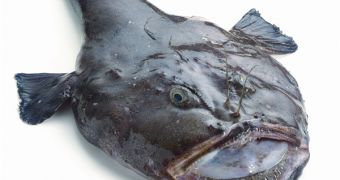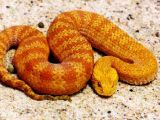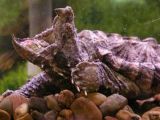1.There is a whole order of fish, comprising 18 families, called anglerfish. The first spiny ray of the dorsal is located on the head and transformed into line and esca (bait), aimed for attracting prey to the mouth, imitating small marine creatures making the fish's food.
The most famous fish of this order belong to the genus Lophius (monkfish, goosefish, fishing-frog, frog-fish, sea-devil), with a grotesque body shape. Despite this, they are of great commercial interest, the meat being compared to lobster tail in taste and texture. In Japan, each fish can cost up to $150; and the liver alone, an appreciated delicacy, can go up to $100.
Fishing-frogs have three long filaments (modified rays of the dorsal fin) sprouting from the middle of their head. The first line with esca is employed as a lure to attract other fishes, which the monkfish then swallows whole with its enormous mouth. The jaws reaction is automatic, being determined by whatever touches the esca. Some abyssal anglerfish have luminous baits for attracting their preys!
2.Death adders (Acantophis) make one of the smallest Australian snakes. They do not overcome 1 m (3.3 ft) in length, still they possess one of the most powerful venoms amongst venomous snakes: it can kill a man through paralysis in 24-48 hours.
These snakes do not actively hunt, but attract their prey towards them using a special bait.
Hunting death adders bury themselves in the substrate (leaf litter, soil or sand) leaving above the ground just their head (with a camouflage color) and their tail. The tip of the tail is transformed into a caudal bait, which is positioned in front of their head. The movements of the reddish bait makes it resemble a worm, attracting foraging lizards, birds or mammals. When in the adder's range, the snake will perform the quickest strike of any snake, just 0.13 of a second! The prey does not even realize what happens until dead.
3.The alligator snapper turtle (Macrochelys temminckii) has a red wormlike appendage on the end of its tongue employed for attracting prey. The turtle lies on the bottom of the water, opening widely its jaws and wiggling the "worm". Fishes enter the turtle's mouth to grab the bait, the turtle snaps its mouth shut.
4.In southern Asia, there lives the chaca catfish. They bury themselves on soft substrate for hunting. Like most catfish, they have maxillary barbels used to lure fish closer to their mouth. The barbels resemble moving worms. The chaca quickly opens its large mouth, forming a vacuum that pulls in water and prey fish, sometimes half the chaca's length. The mouth can be used for propulsion; when frightened, they gulp water and expel it through their gills, a movement resembling the mechanism used by octopuses and squids.

 14 DAY TRIAL //
14 DAY TRIAL // 

